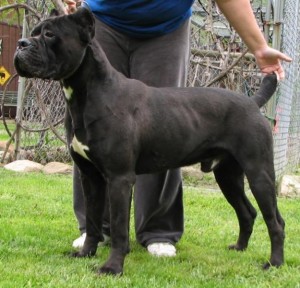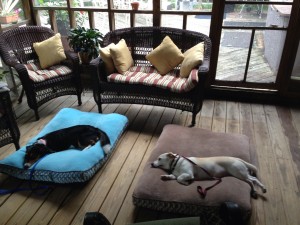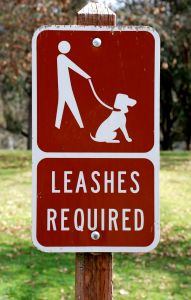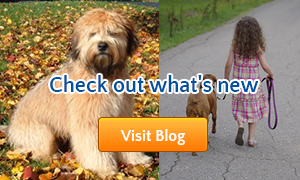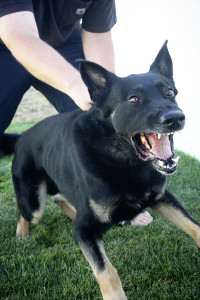 Your Dog’s Mindset
Your Dog’s Mindset
When I first got started training dogs in the mid-90′s I was a young guy. At that time I really had a black and white view of dogs and behavior. Generally my thought was ‘this behavior is bad, let’s correct it’ and ‘that behavior is good, let’s reward it’. It’s worth noting that this isn’t an incorrect style of thought seeing as a basic rule of behavior is ‘that which is rewarded is more likely to reoccur and that which is corrected is less likely to occur.’
Now, the reason I thought the above was THE RULE TO DOG TRAINING was because that mindset is what worked for me. In other words, with my own dogs and dogs that I was training, I could simply correct bad behavior and reward good behavior and I was able to train some really amazing dogs.
Fast forward a couple decades and I’ve worked with thousands of dog owners. I’ve realized it’s not as simple as correct the bad and praise the good.
I’ve realized it’s all about creating a ‘baseline’ for you and your dog.
Dog Training Baseline?
You see, I realized after some time that I could simply correct bad behavior and praise good behavior because, without realizing it, I had already created a solid baseline for my dogs. By baseline I mean a state of being where my dog’s minds were generally calm, where they were generally rational, thinking beings.
In that state of mind the dog is highly receptive to new learning. He’s much less likely to ‘act out’ or ‘disobey’.
But I was creating this baseline without realizing it. In fact, most good dog trainers and a lot of good dog owners do this as well. It’s nothing they’re necessarily thinking about doing. It’s something that just happens.
For example, at our Salt Lake City dog training company we get some really challenging cases of dogs with major aggression problems, heavy anxiety issues, etc. With very few exceptions we can take that dog and by the next day he or she will have made a complete turn around.
And often this is with very little training, period. It’s simply a case of us creating an atmosphere, or baseline, where the dog’s mind can finally calm down and be receptive to new learning.
Now, let’s say we take that same dog, turn him around in one day, then give him back to the owner. He will almost IMMEDIATELY go back to his negative behaviors.
It was realizations such as this that helped me understand that it is far more than simply correcting the bad and praising the good that gets us to a trained dog.
What does the baseline look like?
 Look at the image here. It was created by a famous artist, don’t make fun of it’s rudimentary appearance.
Look at the image here. It was created by a famous artist, don’t make fun of it’s rudimentary appearance.
This is an image of what I’d call a dog’s mindset spectrum. On one end of the spectrum you’ve got complete control/obedience/structure. We don’t want your dog living in that extreme of the spectrum. That’s a dog who is a robot. Is always under command. Doesn’t have any fun.
We also don’t want your dog on the other extreme. On the other extreme is where fear, anxiety, aggression, destruction, and other bad behaviors live.
Now let’s picture we divide that spectrum in half. Most dogs I meet for the first time are living in the left half of that spectrum. In other words, the baseline their owners have created is one where the dog’s mind isn’t right. He’s prone to anxiety and stress.
If you take a dog living at that baseline and add a simple stressor the dog is so quick to jump to the complete extreme and become aggressive, fearful, highly anxious, etc.
Picture this in your mind. Picture the dog who is on a walk and simply SEES another dog and flips out. That dog is living in the left half of the spectrum and one small thing is too much to handle.
Or picture the dog who SEEMS normal in every day life but suddenly gets aggressive or anxious or fearful with a guest in the house. That dog is living on the left half without the owner realizing it and all it took was one stressor and the dog is having a fit.
I want to reiterate this point. Many times dog owners don’t even realize this. More often than not our clients will talk about how their dogs are normally so good, normally so well behaved, normally such good pups….it’s just that when such and such occurs the dogs act poorly.
They think that all we need to do is train the dog during those moments when the dog acts poorly. They don’t realize there is a baseline created where the dogs live all the time, and that is what needs to change.
In reality, we need to change the entire baseline. We need to change the dog’s mindset when things AREN’T going wrong, and there are no stressors, such that when the stressor presents itself the dog is already living in the upper half of that spectrum.
Look at the image again. When the dog is living in the upper half, ideally the upper 1/4, it is literally such a huge mental jump for that dog to turn aggressive or anxious or fearful. It becomes next to impossible to get that dog out of sorts because his mind is already right.
I always tell dog owners to think about someone they’ve known in their past. You know, it’s the guy or girl who always seems to be in altercations. It may be a fist fight, an arguing match, or explosion of temper. However their anger/stress presents itself it seems as if it’s always right there at the surface ready to explode.
Now ask yourself, is that person just unlucky? Do they somehow get dealt a bad hand and bad things happen to them? Or is it that the person shows a pattern of bad decisions dealing with impulse control, perhaps addictions, and a lack of desire to change? They could try to address the moments when they lose their temper, and they should. But they’ll get so much more mileage out of creating a life that has better discipline at ALL TIMES, not just the stressful ones.
Would you agree?
How do you create a dog training baseline?
When I’m presenting these ideas to dog owners in person it’s usually at this point that I’m getting a lot of nods and ‘that makes sense’. If this isn’t making sense write me a comment below with a question.
But, of course, this line of thinking leads to ‘okay, how do we fix our baseline?’
Bad news. I don’t have a definitive way. There are a lot of people who have a lot of ‘dog sense’ or are ‘dog savvy’ and they’re going to find that many things they do are naturally calming and naturally establish the structure their dogs crave.
That doesn’t mean that if you aren’t dog savvy that you can’t create this. It just means that you’ll have to be more conscious about how you’re raising your dog and the interactions you have. I don’t think there’s an exhaustive list I could create on how to create the right baseline for your dog but the following points can definitely help you.
Note: this isn’t to say that everyone must do all these things. It also doesn’t mean that if you aren’t doing these things that you aren’t creating the right baseline. Heck, I’m not doing all of these things with my own dogs. These aren’t hard and fast rules, simply guidelines and they are in no particular order:
- Be careful of the affection you give your dog. Many people are using their dog to fill an emotional void. I’m not saying that’s incorrect, anyone who knows me knows that I’m not the guy to go around giving emotional advice. But what I am saying is that many people use affection towards their dog to fill a void in their own life. They are constantly touching, talking to, treating, thinking about, worrying about, and searching for the affection of their dog. This is WAY too much responsibility to put on a dog and this will create an enormous amount of stress.
- Make your ‘comings and goings’ neutral. When you get too excited when you come home and too regretful when you leave this creates an association that your comings and goings are emotionally saturated. Don’t do this. That makes it far too exciting when you’re home and far too sorrowful when you’re gone. We want your dog on an even plane, not in constant emotional upheaval.
- Many dog owners are going to need to keep their dog off the furniture. This isn’t the case with everyone, but for dogs living with a lot of stress or on the wrong end of the spectrum this can be a necessity.
- Don’t let your dogs do crap. Stop letting them pull on a leash. Stop letting them bark at everything. Stop letting them rush through doors. Stop letting them be destructive. Just stop it! Inevitably I get the question with this of ‘well…well…how?’ Nope, sorry, you don’t get to ask that question. There are literally volumes of material at your disposal to help you with this. You don’t get to claim ignorance. My entire dog training website is full of articles and tips, we’ve created an entire line of dog training videos to help you, and you can even email us to see if we know of a dog trainer in your neighborhood not to mention the scads of information from many other great trainers out there. When you claim that you don’t know how to do something it’s simply because you haven’t taken initiative yet. Stop that. Get to work.
- DO teach your dogs to do good crap. Why doesn’t your dog hold a ‘down-stay- for a half hour? Why doesn’t he come when called? Why doesn’t he ‘listen’ or ‘obey’ or ‘mind’? Because you haven’t taught him to! Stop that. Get to work.
- Have a calming presence. Yes, you can play wild. Yes, you can run around and get goofy with your dog. But there is a season for everything. Don’t allow your dog to take the initiative and monopolize your time with play and requests for play. Instead you initiate it and dictate what play is okay. When you aren’t doing that, be calm with your dog.
I could go on and on with various other iterations of these ideas and concepts. I’m hoping, though, that you’ve got the picture now. I’m hoping that as you’ve read this you’ve thought of things that you can change with you and your dog’s relationship.
Now go and do them.



